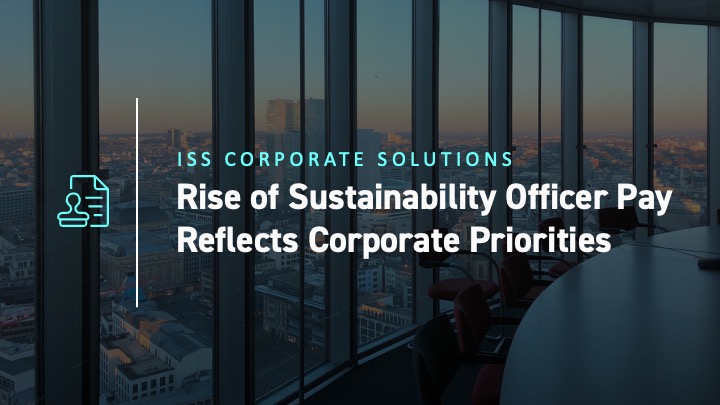Corporations are increasingly adding the role of Chief Sustainability Officer to their executive teams — at pay levels that place them among the top five Named Executive Officers — reflecting rising recognition of environmental, social and governance risk. In this study, we examine the prevalence of these positions among NEOs and how aggregate pay compares with other executive roles. Separately, we look at how the pay of Chief Risk Officers and Supply Chain Officers compares with other NEOs.
Key Takeaways
- Fewer than 1% of NEOs were CSOs in fiscal 2021
- The median total compensation of CSOs is higher than the median total compensation of other NEOs, excluding CEOs and CFOs, while the median total compensation of CROs and Supply Chain Officers is lower than others
- The median total compensation of Chief Sustainability Officers is higher than that of their risk and supply chain colleagues
- The median pay for CSOs has increased by 32.8% in three years, outpacing the increase of 21.8% for non-CEO, non-CFO NEOs
CSOs comprise a number of different official titles and their duties may vary. For the purposes of this study, NEOs were classified as a Chief Sustainability Officer based on their title and primary responsibilities. NEOs whose position indicated the primary responsibility as sustainability and related issues such as ethics, governance, diversity, ESG, environment and corporate social responsibility were categorized as a CSO. Of non-CEO, non-CFO named executive officers in the Russell 3000, 47 were identified as CSOs in fiscal 2021, representing less than 1% of NEOs.
These sustainability officers include Chief Ethics Officers, Chief Sustainability Officers, ESG Officers, Environment Officers, Diversity Officers, Chief Governance Officers and Chief Responsibility Officers. One company has two NEOs with responsibilities in sustainability: a Chief Sustainability Officer and a Head of Diversity and Inclusion.
CSOs Among the Highest Paid Executives
The Materials and Consumer Discretionary sectors in the Russell 3,000 had the most CSOs among their NEOs with 11 each. Industrials had 8 CSOs among the ranks of the highest paid executives; Consumer Staples had four; each of Financials, Information Technology, and Utilities sectors had three; Health Care had two, while Real Estate and Energy each had one.
In addition, 73 CROs and 39 Supply Chain Officers were named as NEOs in fiscal 2021 among Russell 3000 companies. CROs and Supply Chain Officers were included in this study because their duties in some cases could be said to overlap with sustainability roles. Supply Chain Officers are common in the same sectors as CSOs, with the addition of the Consumer Staples and Health Care sectors. By far, the most CROs worked in the Financials sector, where their responsibilities are more focused on financial risk rather than ESG risk. Nonetheless, Chief Risk Officers’ roles are likely to increasingly incorporate assessments of ESG-related risks, particularly climate risk, as banks and other financial institutions face climate stress tests and regulatory pressure to quantify their exposure to climate change over the coming years.
Sustainability Officers’ Pay v. Other NEOs (Russell 3000)
Source: ISS Corporate Solutions Data Analytics, based on Fiscal Year 2021 Total Direct Compensation as disclosed in Summary Compensation Tables

Pay Comparisons
As the table above shows, CSOs receive higher median compensation than NEOs in general when CEOs and CFOs are excluded. However, average pay favors the other NEOs. The interquartile range for non-CEO/CFO NEOs is much wider than that for their sustainability, risk and supply chain colleagues. However, lower quartile total compensation for CSOs is higher than for other NEOs. In general, CSOs earn more in aggregate than either CROs or Supply Chain Officers.
While CSOs represent only a small proportion of all NEOs today, both numbers and pay are rising. The total more than doubled to 47 in fiscal 2021 from 23 in 2019 and median total compensation climbed by 32.8% over that period. By comparison, pay rose 21.8% for other types of NEOs.
Increase in CSO Pay vs. Other NEOs (excluding CEOs/CFOs)
Source: ISS Corporate Solutions Data Analytics, based on Fiscal Year 2021 and 2019 Total Direct Compensation as disclosed in Summary Compensation Tables

Although it is difficult to draw significant conclusions from a relatively small dataset, pay changes will be worth monitoring in the future, as CSO positions are likely to move increasingly into the spotlight. As global demand rises for the limited number of executives with sustainability skills and credentials, expect that such jobs will demand a premium in compensation.
It will be interesting to see how many CSOs break into the top ranks of NEOs as companies create dedicated roles for managing sustainability programs in their companies, in response to pressure from regulators, shareholders, and other stakeholders, and internal employees are elevated to higher paid positions with greater responsibility. As more and more boards put, greater emphasis on well managed sustainability programs with high visibility, we may see more CSOs joining the ranks of top executives.
By: Paul Hodgson, Senior Editor, ISS Corporate Solutions




